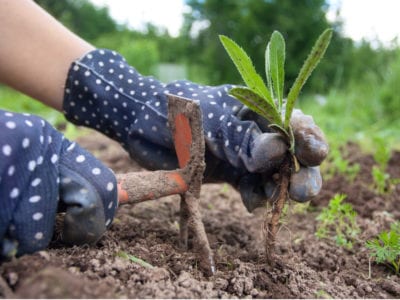By Spy Uganda
“How do I kill weeds?” is an existential gardening question. Because without weed control, there would be no gardening.
There is plenty of advice out there, but it can be difficult to know what’s the most effective way of controlling weeds in your environment. Here is an overview of the six best tips, so you can get a firm grip on minimizing the weeds in your yard.
-
Leave No Room For Weeds
:max_bytes(150000):strip_icc():format(webp)/GettyImages-1149028971-517f1c32ef56493a9342c2aa66303a3a.jpg)
Weeds, like any other plants, compete for light, nutrients, and water. If there is open space, it’s much easier for weeds to get a foothold than if the space is already occupied by other established plants.
Leaving no or as little room for weeds as possible means to plant densely. At the same time, however, you also need to prevent overcrowding as plants grow and mature. Overcrowding will lead to poor air circulation and can trigger plant diseases.
For example, you may fill a bed with perennials such as echinacea, which are spaced apart one to three feet, depending on the variety. When you first plant them, there will be a lot of space between the individual plants. One option is to plant the echinacea slightly closer together, and take some out and move them in future years once they get bigger. Keep in mind, however, that not all plants like being moved. Or, you can follow the recommended spacing and plant or seed annuals in the empty space to keep the weeds out.
Planting groundcovers is another excellent way to keep out weeds. When selecting a groundcover, make sure that it is a good fit for surrounding plants. If it’s a fast and vigorous grower and the other plants are moderate or slow growers, the groundcover might take over. Also make sure that the height of the groundcover is low enough so it won’t overshadow the other plants.
-
Mulch
:max_bytes(150000):strip_icc():format(webp)/GettyImages-1211787309-c955f885bc394b398d247dabf91c87bd.jpg)
Mulching is another great method to prevent weeds from growing. Organic mulch like bark or pinestraw won’t last as long as an inorganic weed barrier, but organic mulch has a lot of other benefits.
To help smother extensive weeds in beds, try laying cardboard or thick layers of newspaper in the bed before you add mulch. Water the layer to help hold it in place while you’re spreading mulch. Depriving weeds of water and sunlight kills the weeds, but this can take weeks. However, it’s easy to dig through the decomposing paper to add plants to your weed-free beds.
-
Know Your Weeds
:max_bytes(150000):strip_icc():format(webp)/GettyImages-177588241-167776209e1f48999dcc3d24c61f91f2.jpg)
For effective weed control, it’s important to know the weeds you are dealing with, especially if they are weeds that you find frequently or in many places in your yard. Identify the weed: is it an annual or a perennial? What type of root does it have? When does it bloom? Knowing these things helps you to remove it fully, hit the weed at the right time, and dispose of it in a safe way. Some weeds, such as garlic mustard, should not even be composted and must be thrown in the garbage instead, because the seeds can remain viable or the plant can re-root after removal.
If you did not get around to removing the weeds before they bloom, make sure to at least deadhead them before they set seeds and can spread further. Never leave the pulled plants lying around. At the flowering stage, the weeds may continue to develop seeds, and if they already have seed heads, the seeds will be dispersed by the wind.
-
Don’t Stir Up the Soil
:max_bytes(150000):strip_icc():format(webp)/GettyImages-157193336-a55a76d464094aa09e8a2ede9afb8084.jpg)
What sounds almost counterintuitive is a basic rule of weed control that has to do with seed germination. Most weed seeds need light to germinate and will do so only in the top two inches of soil. Therefore, when you till or dig up the soil, you are catapulting weed seeds—which are naturally present by the thousands in any given soil—into the sunlight where they need to be in order to start germination. Therefore, after disturbing the soil, plant in it right away and/or cover it with mulch to prevent weeds from growing
- Use The Right Tools
:max_bytes(150000):strip_icc():format(webp)/GettyImages-167458496-c43168abdd8d450f9a0b9ab6eeca8bf6.jpg)
The right tool for removing weeds is important because the goal is to remove the entire weed with all its roots (assuming you know what type of weed it is and what the root looks like).
There are dozens of different weeding tools out there, some multi-purpose tools, others specialized, such as a dandelion puller. Which tools you use is a question of personal ergonomic preference and budget, but make sure that the tool fits the basic requirement of reaching deep roots, and surface tools for shallow roots. For taproots, a regular garden shovel is often the best option.
- Chemical Weed Control
:max_bytes(150000):strip_icc():format(webp)/GettyImages-531400306-1aee3a4109944ae38c18b393b306cf09.jpg)
Killing weeds with inorganic chemicals should be your last resort. The hundreds of weedkillers on the market fall into two basic categories: pre-emergence weed killers for weed prevention, and post-emergence weed killers that kill the actual plants. It is crucial to know which weeds you are battling and their lifecycle in order to treat them with the right type of weed killer at the right time.
When using broad-spectrum herbicides such as glyphosate-based herbicide, keep in mind that it kills everything it lands on, not just the weeds.





